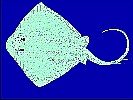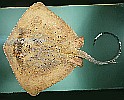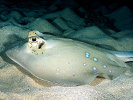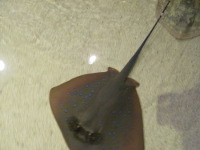Neotrygon kuhlii
(Müller & Henle, 1841)
Bluespotted stingray
Classification: Elasmobranchii Myliobatiformes Dasyatidae
Reference of the original description
Systematische Beschreibung der Plagiostomen. Berlin, Veit, pp. 1–200
Systematische Beschreibung der Plagiostomen. Berlin, Veit, pp. 1–200
Image of the original description
.jpg)
Neotrygon kuhlii (Müller & Henle, 1841)
.jpg)
Neotrygon kuhlii (Müller & Henle, 1841)
Synonyms / new combinations and misspellings
Amphotistius kuhlii, Dasyatis cf. kuhlii, Dasyatis kuhli, Dasyatis kuhlii, Dasyatis maculatus, Dasyatis (Amphotistius) kuhlii, Dasybatus kuhlii, Dicerobatis kuhlii, Neotrygon cf. kuhlii, Neotrygon kuhli, Trygon kuhlii, Trygon (Trygon) kuhlii
Amphotistius kuhlii, Dasyatis cf. kuhlii, Dasyatis kuhli, Dasyatis kuhlii, Dasyatis maculatus, Dasyatis (Amphotistius) kuhlii, Dasybatus kuhlii, Dicerobatis kuhlii, Neotrygon cf. kuhlii, Neotrygon kuhli, Trygon kuhlii, Trygon (Trygon) kuhlii
Types
Neotrygon kuhlii
Syntype: MNHN: A-7931; RMNH: 2472; Lectotype: MNHN: 2440; Paralectotype: MNHN: 2440;
Dasyatis maculatus
Holotype: MGHSJ: ?;
Neotrygon kuhlii
Syntype: MNHN: A-7931; RMNH: 2472; Lectotype: MNHN: 2440; Paralectotype: MNHN: 2440;
Dasyatis maculatus
Holotype: MGHSJ: ?;
Description :
Citation: Neotrygon kuhlii (Müller & Henle, 1841): In: Database of modern sharks, rays and chimaeras, www.shark-references.com, World Wide Web electronic publication, Version 01/2026
Please send your images of "Neotrygon kuhlii" to info@shark-references.com
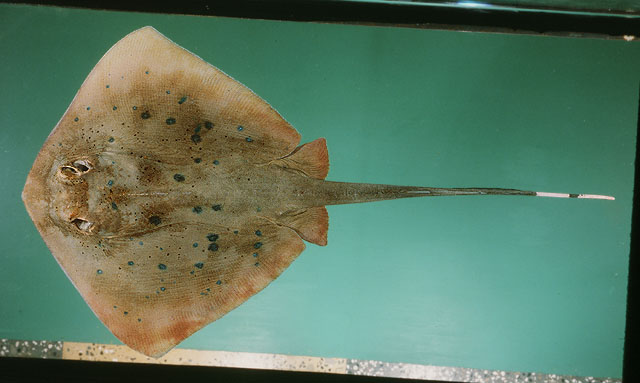
Neotrygon kuhlii (Müller & Henle, 1841), © Randall, J.E, www.fish-base.org

Neotrygon kuhlii (Müller & Henle, 1841), © Randall, J.E, www.fish-base.org
Common names
 Raie à points bleus,
Raie à points bleus,  Requin raie,
Requin raie,  Ble-spotted stingaree,
Ble-spotted stingaree,  Ble-spotted stingray,
Ble-spotted stingray,  Blue spotted sting ray,
Blue spotted sting ray,  Blue spotted stingray,
Blue spotted stingray,  Blue-spotted maskray,
Blue-spotted maskray,  Blue-spotted stingaree,
Blue-spotted stingaree,  Blue-spotted stingray,
Blue-spotted stingray,  Bluespotted maskray,
Bluespotted maskray,  Bluespotted stingray,
Bluespotted stingray,  Kuhl"s stingray,
Kuhl"s stingray,  Uge ponteado
Uge ponteado
 Raie à points bleus,
Raie à points bleus,  Requin raie,
Requin raie,  Ble-spotted stingaree,
Ble-spotted stingaree,  Ble-spotted stingray,
Ble-spotted stingray,  Blue spotted sting ray,
Blue spotted sting ray,  Blue spotted stingray,
Blue spotted stingray,  Blue-spotted maskray,
Blue-spotted maskray,  Blue-spotted stingaree,
Blue-spotted stingaree,  Blue-spotted stingray,
Blue-spotted stingray,  Bluespotted maskray,
Bluespotted maskray,  Bluespotted stingray,
Bluespotted stingray,  Kuhl"s stingray,
Kuhl"s stingray,  Uge ponteado
Uge ponteado
Short Description
Original Diagnosis after LAST, WHITE & SÉRET, 2016 [23790]: A medium-sized Neotrygon of the kuhlii-complex (reaching at least 30 cm DW) with the following combination of characters: disc broader than long, width ~1.2 times length; pectoral apices narrowly rounded; snout rather fleshy, broadly angular, angle ~107°, length 1.7–2.1 times interorbital width; maximum width relatively well back on disc, length from snout tip to pectoral-fin insertion 1.8–1.9 times and disc width 2.5–2.6 times horizontal distance from snout tip to maximum disc width; preoral length 2.4–2.8 times mouth width; internasal distance 1.5–1.8 in prenasal length; interspiracular distance 13–15% DW; nostril length 2.8–4.1% DW; nasal curtain width 8–8.3% DW; small mouth, width 6.4–6.8% DW; horizontal distance from cloaca to caudal sting base ~55% of disc length; thornlets present in nuchal region, absent from tail in all sizes; dermal denticles absent; pectoral-fin radials 113 (based on new specimen); total vertebral centra (including synarcual) 133, trunk centra (including synarcual) 39; blue spots very small and sparse, largest spot on disc 0.3–0.5 times eye width; 0–6 (mean 3.0) blue spots on medial belt, largest ~2.1% DW; mask-like marking pronounced, not covered with dark peppery spots; ventral surface of disc and pelvic fins with broad dark greyish submarginal bands; ventral tail fold and adjacent tail bluish grey when fresh.
Diet: north-east Australia (data base: 131 specimens): Polychaetes were the most important prey category (71,5 %IRI), carids were the second most important prey category (24,5 %IRI) [14696].
Original Diagnosis after LAST, WHITE & SÉRET, 2016 [23790]: A medium-sized Neotrygon of the kuhlii-complex (reaching at least 30 cm DW) with the following combination of characters: disc broader than long, width ~1.2 times length; pectoral apices narrowly rounded; snout rather fleshy, broadly angular, angle ~107°, length 1.7–2.1 times interorbital width; maximum width relatively well back on disc, length from snout tip to pectoral-fin insertion 1.8–1.9 times and disc width 2.5–2.6 times horizontal distance from snout tip to maximum disc width; preoral length 2.4–2.8 times mouth width; internasal distance 1.5–1.8 in prenasal length; interspiracular distance 13–15% DW; nostril length 2.8–4.1% DW; nasal curtain width 8–8.3% DW; small mouth, width 6.4–6.8% DW; horizontal distance from cloaca to caudal sting base ~55% of disc length; thornlets present in nuchal region, absent from tail in all sizes; dermal denticles absent; pectoral-fin radials 113 (based on new specimen); total vertebral centra (including synarcual) 133, trunk centra (including synarcual) 39; blue spots very small and sparse, largest spot on disc 0.3–0.5 times eye width; 0–6 (mean 3.0) blue spots on medial belt, largest ~2.1% DW; mask-like marking pronounced, not covered with dark peppery spots; ventral surface of disc and pelvic fins with broad dark greyish submarginal bands; ventral tail fold and adjacent tail bluish grey when fresh.
Diet: north-east Australia (data base: 131 specimens): Polychaetes were the most important prey category (71,5 %IRI), carids were the second most important prey category (24,5 %IRI) [14696].
Distribution
Tropical South-West Pacific, off the Solomon Islands; Santa Cruz Islands and Guadalcanal [23790] Source: www.gbif.org
Tropical South-West Pacific, off the Solomon Islands; Santa Cruz Islands and Guadalcanal [23790] Source: www.gbif.org
Human uses
fisheries: commercial
fisheries: commercial
Biology
Exhibit ovoviparity (aplacental viviparity), with embryos feeding initially on yolk, then receiving additional nourishment from the mother by indirect absorption of uterine fluid enriched with mucus, fat or protein through specialised structures [733]. Distinct pairing with embrace [17086]. Litters size at birth 16 cm (Ref. 37816); Java form born at 11-16 cm WD, Bali form born at ~17 cm WD. Gives birth to litters of 1-2 pups; no reproductive synchronicity [2539]. Inhabits sandy areas among coral reefs. A solitary species found on sandy bottoms near rocky or coral reefs [1658]. Usually found in deeper water but moves onto the reef flat and into shallow lagoons at high tide [1658]. Occasionally covers itself with sand, leaving only its eyes and tail visible (Ref. 37816). Feeds on crabs and shrimps [536]. A carnivore [17641]. Also Ref. 58534.
Exhibit ovoviparity (aplacental viviparity), with embryos feeding initially on yolk, then receiving additional nourishment from the mother by indirect absorption of uterine fluid enriched with mucus, fat or protein through specialised structures [733]. Distinct pairing with embrace [17086]. Litters size at birth 16 cm (Ref. 37816); Java form born at 11-16 cm WD, Bali form born at ~17 cm WD. Gives birth to litters of 1-2 pups; no reproductive synchronicity [2539]. Inhabits sandy areas among coral reefs. A solitary species found on sandy bottoms near rocky or coral reefs [1658]. Usually found in deeper water but moves onto the reef flat and into shallow lagoons at high tide [1658]. Occasionally covers itself with sand, leaving only its eyes and tail visible (Ref. 37816). Feeds on crabs and shrimps [536]. A carnivore [17641]. Also Ref. 58534.
Remarks
shark-references Species-ID=4117;
shark-references Species-ID=4117;
Parasites (arranged by Jürgen Pollerspöck)
Myxosporea
Monogenea
Cestoda
Trematoda
Copepoda
Isopoda
Hirudinea
Myxosporea
- Chloromyxum kuhlii Gleeson & Adlard, 2012 [32173] [15542]
- Kudoa hemiscylli Gleeson, Bennett & Adlard, 2010 [21484]
Monogenea
- Dendromonocotyle kuhlii Young, 1967 [17104] [17437] [9445] [9460]
- Empruthotrema stenophallus Chisholm & Whittington, 2005 [7581]
- Monocotyle kuhlii Young, 1967 [17104] [17001]
- Monocotyle tritestis Young, 1967 [17104] [17001]
- Neoentobdella australis (Kearn, 1978) [15241]
Cestoda
- Acanthobothrium bengalense Baer & Euzet, 1962 [16175] [16448]
- Acanthobothrium confusum Baer & Euzet, 1962 [16448] [28741]
- Acanthobothrium coronatum (Rudolphi, 1819) Van Beneden, 1850 [16408] [17089] [16101] [16448]
- Acanthobothrium herdmani Southwell, 1912 [26667] [16408] [16247] [17089] [16101] [28741]
- Acanthobothrium pintanense Wang, 1984 [16435] [28741]
- Acanthobothrium uncinatum (Rudolphi, 1819) [16408] [17089] [16101]
- Acanthobothrium zschokkei Baer, 1948 [16247]
- Anteropora sp. [23959]
- Anthobothrium ceylonicum Southwell, 1912 [26667]
- Anthocephalum healyae Ruhnke, Caira & Cox, 2015 [22027]
- Anthocephalum odonnellae Ruhnke, Caira & Cox, 2015 [22027]
- Balanobothrium parvum Southwell, 1925 [17089] [16101]
- Barbeaucestus shipleyi (Southwell, 1912) [26667] [16247] [10842] [25321]
- Cephalobothrium aetobatidis Shipley & Hornell, 1906 [16410]
- Cephalobothrium longisegmentum Wang, 1984 [16435]
- Dollfusiella michiae (Southwell, 1929) [16252] [16112]
- Dollfusiella spinosa Schaeffner & Beveridge, 2013 [19694] [21816]
- Dollfusiella spinulifera (Beveridge & Jones, 2000) [19694] [21816]
- Echinobothrium longicolle Southwell, 1925 [16430] [24952] [19536]
- Echinobothrium sp. [19536]
- Eutetrarhynchus leucomelanus (Shipley & Hornell, 1906) [16112]
- Eutetrarhynchus sp. [29720]
- Gilquinia sp. [24952]
- Halysiorhynchus macrocephalus (Shipley & Hornell, 1906) [16112]
- Hexacanalis abruptus (Southwell, 1911) Perrenoud, 1931 [16410]
- Kotorella pronosoma (Stossich, 1901) [21816]
- Lecanicephalum sp. [24952]
- Mecistobothrium johnstonei (Southwell, 1929) [16112]
- Onchobothrium farmeri (Southwell, 1911) [16408] [17089] [16101]
- Phyllobothrium blakei Shipley & Hornell, 1906 [16412] [16443] [16443]
- Phyllobothrium lactuca Van Beneden, 1850 [16412] [16408] [16443] [16443] [16443]
- Phyllobothrium ptychocephalum Wang, 1984 [16435]
- Polypocephalus elongatus (Southwell, 1912) [16247]
- Polypocephalus kuhlii Vankara, Vijayalakshmi & Vijayalakshmi, 2006 [16216]
- Prochristianella aciculata Beveridge & Justine, 2010 [16097] [17404] [21816]
- Prochristianella butlerae Beveridge, 1990 [17404] [21816]
- Prochristianella clarkeae Beveridge, 1990 [16252] [16112] [17404] [21816]
- Prochristianella odonoghuei Beveridge, 1990 [16112]
- Prochristianella omunae Beveridge & Justine, 2010 [16097]
- Pterobothrium lintoni (Maccallum, 1916) Dollfus, 1942 [16112]
- Pterobothrium sp. [16112]
- Rhinoptericola aetobatidis (Shipley & Hornell, 1906) [16112] [24246]
- Scalithrium trygonis (Shipley & Hornell, 1906) [10842]
- Spongiobothrium variabile Linton, 1889 [16443]
- Tetrarhynchobothrium rossi (Southwell, 1912) [16255] [16112]
- Trygonicola macroporus (Shipley & Hornell, 1906) [16112] [21816]
Trematoda
- Staphylorchis cymatodes (Johnston, 1913) [11242]
Copepoda
Isopoda
- Gnathia grandilaris Coetzee, Smit, Grutter & Davies, 2008 [21221] [22155]
- Gnathia maculosa Ota & Hirose, 2009 [22155]
- Gnathia rufescens Ota, 2015 [22155]
- Gnathia teruyukiae Ota, 2011 [22155]
- Gnathia trimaculata Coetzee, Smit, Grutter & Davies, 2009 [17188] [22155]
Hirudinea
- Branchellion plicobranchus Raj, 1953 [28595]








